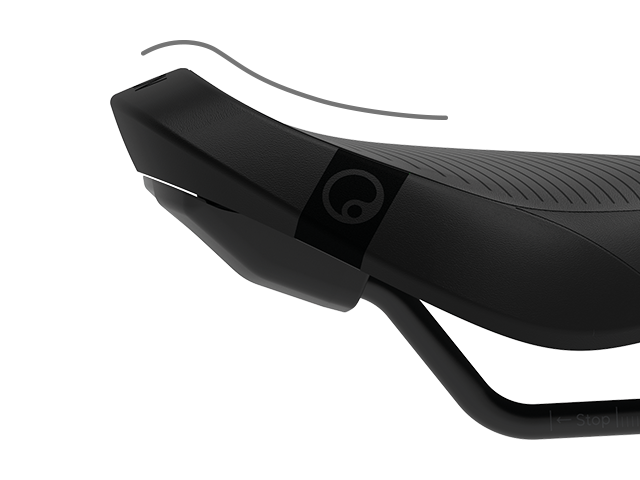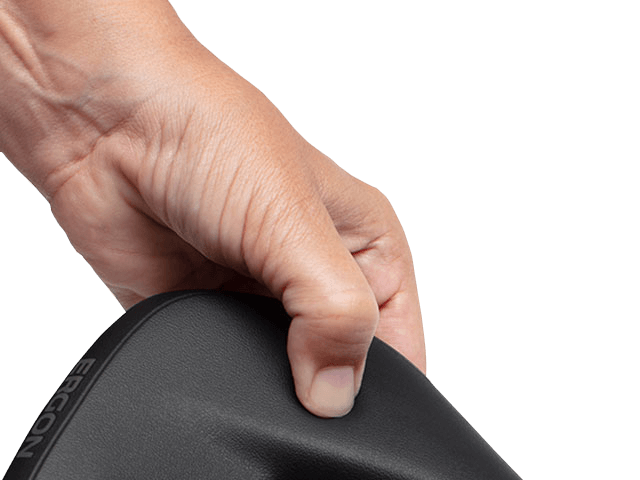SM E-Mountain Pro Men
- For ambitious male e-mountain bikers
- Relief of the perineal area
- Maximum uphill support

**Price can vary by country.
The SM E-Mountain Pro Men significantly improves the rider’s setaed position while climbing. The upturned rear ramp gives you a stable, effort-saving hold when climbing uphill.

The saddle’s nose features a wider and flatter design for added comfort and support as the body position moves forward and lower during very steep challenging climbs.

The minimal supportive padding delivers excellent trail feedback without compromising overall riding comfort. An athletic design that provides a perfect balance of support and performance.

The progressive relief channel, which deepens towards the rear, leads to an opening through the saddle shell. Too much pressure in this area often leads to discomfort and numbness in the genital area. This design gives the saddle shell more forgiveness as well as specifically relieves perineal pressures.

The new OrthoCell® material helps you to achieve your best performance without any complaints. These inlays, which are more durable and lighter than gel, ensure the best pressure distribution and provide the highest rebound force. This means they follow the movements of the pelvis with every turn of the crank, but return to their starting position very quickly.

The padding consists of a lightweight AirCell® padding, which we have designed to be comfortable yet high performance. The pressure of the body weight on the seat area is distributed much more effectively with OrthoCell® inlays and AirCell® padding, highly increasing the supportive qualities of the saddle.

For added comfort, the SM E-Mountain Pro Men features special side flanks. The anti-friction material allows for ease of leg clearance as well as smooth position changing for dynamic riding ease.

A Topeak QuickClick mount is integrated in all models of the SM-E Mountain series. This removable QuickClick mount allows for Topeak saddlebags to be easily attached in a streamline fashion.

The Ergon development team carried out intensive research on the topic of men’s health. They found that the main cause of complaints when cycling is the saddle. Often times, men experience too much pressure on their perineal area leading to pain, discomfort, numbness and potentially more severe health problems. The SM E-Mountain saddle relieves this pressure with a very specific relief channel as well as better surface area distribution under the bony structures. Through MRT, CT analysis, many prototypes and test riders, we have ergonomically adjusted the saddle to the specific anatomy and needs of men.

Compared to women, the male pelvis tends to be less flexible. This means that men sit more upright on the saddle and put more of their weight distribution on their sit bones. Therefore the transition area between the rear of the saddle and the saddle nose can be kept narrow (Y-shape). This gives the legs more space to pedal.

In contrast to the female anatomy, the male sit bones are more narrow and where the two sides of the pelvis come together in the front is much higher. This results in more pressure being distributed on the male’s sit bones vs. a broader area of sit bones and pubic bones in women. We have taken this significant difference between male and female anatomy into consideration during saddle development.

The correct distribution of pressure is important. In order to protect the sensitive perineal area, the pressure must be shifted to the sit bones and parts of the pubic arch – this is exactly how the relief surface of Ergon men’s saddles works. Due to the more upright sitting male pelvis we have kept the surface flat and even for best possible freedom of movement. For the support we use the highest quality foams.

The shape and size of the saddle must match the sit bone width of the rider to maximize comfort and enjoyment.
The pelvic bone has a unique V-shape and the saddle must offer the sit bones a large contact surface with the ability to meet the demand of different sitting positions. Various saddle widths are offered so that the usable seat surface corresponds to the riders unique sit bone distance.
The more forward and aggressive the rider sits, the further forward the sit bones contact the saddle.
